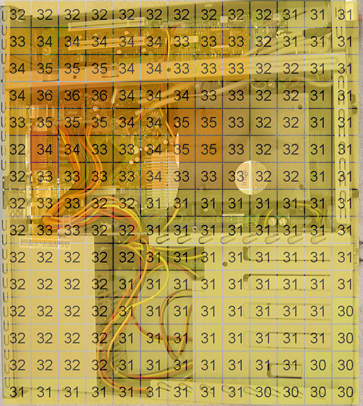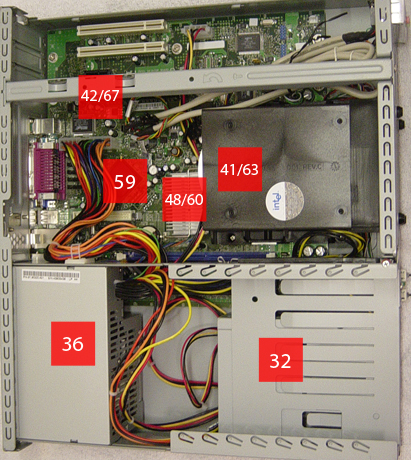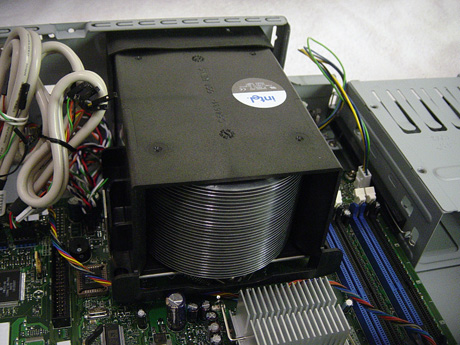Intel's Long Awaited BTX Form Factor
by Purav Sanghani on November 15, 2004 5:31 AM EST- Posted in
- Cases/Cooling/PSUs
Thermals Micro BTX (uBTX)
This is where everything we have heard about the BTX form factor is either proven right or wrong. Intel claims BTX the better design to efficiently cool more components with less equipment while using less power and space. Intel released a virtual press kit on their BTX form factor in April of this year. Unfortunately, the press kit is a little too general to really draw many conclusions, but feel free to judge for yourself.Intel's press kit reports that the BTX design cools the CPU to 2 degrees lower than the ATX form factor while only providing 40 cubic feet per minute, or 40 cfm with our Type I Thermal Module. ATX, on the other hand, requires 150 linear feet per minute, or 150 lfm.
We performed our inch by inch temperature observation with the D915GMH microBTX motherboard and the Pentium 550 CPU in the AOpen B300 which is 15" in width by 13" in depth.

Click to Enlarge
From our results above we see that the temperatures of each square inch of the case are a few degrees higher than those we found on our ATX Ahanix D.Vine 5 chassis. The warmest pocket of air hovers between the PCIe card, Southbridge, Northbridge, and CPU. This area, which averages about 35 degrees, is warmer than the ATX ambient average of about 32 degrees. Intel's whitepaper was not clear on the equipment they used to get the results in their table but from our results, the standard ATX system performs cooler than the BTX system. The microATX system, however, produced temperatures higher than those of the microBTX system.

Click to Enlarge
The results for the core temperatures of each component shown above also tell us that the microBTX equipment does not exactly perform better than the ATX hardware, but for the amount of fans in the system, microBTX is more efficient when it comes to cost of energy and space. With only the CPU's HSF and the power supply's single 80mm fan, the uBTX system performs at temperatures lower than an uATX system with three case fans and a dedicated CPU HSF.

Click to Enlarge
These temperatures are not set in stone for every processor Intel manufacturers or will release in the future. Each will require a different thermal module according to their Thermal Design Power rating. For example, The Pentium 550J will come bundled with a Type I Stacked-fin module whereas the Pentium 560J will come with the Type I Spiral-fin module. Obviously the spiral-fin module will dissipate heat better than the stacked fins.










77 Comments
View All Comments
ThelvynD - Monday, November 15, 2004 - link
We've been getting in new HP 7100s here at my work center and they've been in the micro-BTX format. I don't any major problems with it so far. Pic below.http://www.picsplace.to/044712/HP-BTX.JPG
Nonsense - Monday, November 15, 2004 - link
#36 - Thanks Purav.Can you tell me - is the PS blowing in or out, and is the CPU fan blowing in or out? I'm still trying to figure where all the air is comming from.
PuravSanghani - Monday, November 15, 2004 - link
#34: If you look at the picture of the backside of the B300 on page 8 there are groups of holes above the VGA expansion slot as well as to the right between the expansion slot and the power supply. There are also holes lining the bottom of the case if you look closely. We were surprised ourselves to find how well passively cooling all of the components in a system would actually work. And from the pictures you can also see there aren't too many holes for a large amount of air to come in through!PuravSanghani - Monday, November 15, 2004 - link
#25: Actually, the front panel connectors *are* standardized and combined into one single plug. We mentioned this on page 8 of the article, "First Look: AOpen B300 BTX case cont'd", in the paragraph where we talk about the auxiliary module.Nonsense - Monday, November 15, 2004 - link
#28 - I don't understand the air flow.If the CPU fan is blowing out the front of the case, then the PS _must_ be blowing in.
Blowing hot air into a case does not sound good. Is that how it works?
If the PS is also blowing out, then you have a vacuum. I do not see any heat comming into the case from the PS, so it must be blowing out...?!
Where is the air comming from that is cooling the graphics card? It looks like mostly dead air in that corner - there are only tiny grills on the back.
Sunbird - Monday, November 15, 2004 - link
From last paragraph of article:"The ATX case used more space and ran louder."
Space is not evil!, its a good thing for when your drop a small screw, or have hands that fit your 6'6" frame. And loudness can be adressed in other just as succesfull ways.
"Don't forget that additional non-redundant fans increase the failure rate of a computer as well - more moving parts."
And what if the single fan on the BTX sollution fails? That is really non-reduntant if you ask me, anyone agree?
Sunbird - Monday, November 15, 2004 - link
#20, I agree, I have a Packard Bell P1 133MHz flat desktop case PC in my workshop and that is almost exactly the same design as this, except the stuff like the optical drive, hard drives and power supply was swapped from the right to the left side of the case, othewise its exactly the same. Glad to see some oldschool designs again, lol#27's idea is brilliant, they quickly implemented something like that with the cases and their front USB options, those LED and power button connector have been around much longer. What's taking them so long?
epiv - Monday, November 15, 2004 - link
skunkbuster - Monday, November 15, 2004 - link
flash in the pants?Zebo - Monday, November 15, 2004 - link
This is going nowhere quick. It's obvious Intel will no longer need it when they make the Dothan desktop transition plus AMD all case and PS manufactures hate the idea. Just wahtever you do don't go buying an $300 Lian Li and $120 PSU since BTX is a flash in the pants.